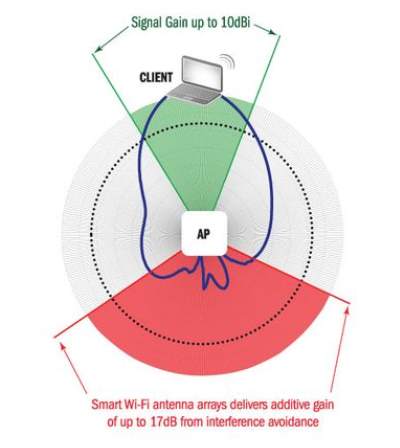Wireless Routers 101
Wi-Fi Features
SU-MIMO And MU-MIMO
Multiple-input and multiple-output (MIMO), first seen on 802.11n devices, takes advantage of a radio phenomenon known as multipath propagation, which increases the range and speed of Wi-Fi. Multipath propagation is based on the ability of a radio signal to take slightly different pathways between the router and client, including bouncing off intervening objects as well as floors and ceilings. With multiple antennas on both the router as well as the client—and provided they both support MIMO—then using antenna diversity can combine simultaneous data streams to increase throughput.
When MIMO was originally implemented, it was SU-MIMO, designed for a Single User. In SU-MIMO, all of the router's bandwidth is devoted to a single client, maximizing throughput to that one device. While this is certainly useful, today's routers communicate with multiple clients at one time, limiting the SU-MIMO's technology's utility.
The next step in MIMO's evolution is MU-MIMO, which stands for Multiple User-MIMO. Whereas SU-MIMO was restricted to a single client, MU-MIMO can now extend the benefit to up to four. The first MU-MIMO router released, the Linksys EA8500, features four external antennas that facilitate MU-MIMO technology allowing the router to provide four simultaneous continuous data streams to clients.
Before MU-MIMO, a Wi-Fi network was the equivalent of a wired network connected through a hub. This was inefficient; a lot of bandwidth is wasted when data is sent to clients that don't need it. With MU-MIMO, the wireless network becomes the equivalent of a wired network controlled by a switch. With data transmission able to occur simultaneously across multiple channels, it is significantly faster, and the next client can "talk" sooner. Therefore, just as the transition from hub to switch was a huge leap forward for wired networks, so will MU-MIMO be for wireless technology.
Beamforming
Beamforming was originally implemented in 802.11n, but was not standardized between routers and clients; it essentially did not work between different manufacturers' products. This was rectified with 802.11ac, and now beamforming works across different manufacturers' gear.
What beamforming does is, rather than have the router transmit its Wi-Fi signal in all directions, it allows the router to focus the signal to where it is needed to increase its strength. Using light as an analogy, beamforming takes the camping lantern and turns it into a flashlight that focuses its beam. In some cases, the Wi-Fi client can also support beamforming to focus the signal of the client back to the router.
While beamforming is implemented in 802.11ac, manufacturers are still allowed to innovate in their own way. For example, Netgear offers Beamforming+ in some of its devices, which enhances throughput and range between the router and client when they are both Netgear products and support Beamforming+.
Get Tom's Hardware's best news and in-depth reviews, straight to your inbox.
Other Wi-Fi Features
When folks visit your house, they often want to jump on your wireless network, whether to save on cellular data costs or to connect a notebook/tablet. Rather than hand out your Wi-Fi password, try configuring a Guest Network. This facilitates access to network bandwidth, while keeping guests off of other networked resources. In a way, the Guest Network is a security feature, and feature-rich routers offer this option.
Another feature to look for is QoS, which stands for Quality of Service. This capability serves to prioritize network traffic from the router to a client. It's particularly useful in situations where a continuous data stream is required; for example, with services like Netflix or multi-player games. In fact, routers advertised as gaming-optimized typically include provisions for QoS, though you can find the functionality on non-gaming routers as well.
Another option is Parental Control, which allows you to act as an administrator for the network, controlling your child's Internet access. The limits can include blocking certain websites, as well as shutting down network access at bedtime.

Jonas P. DeMuro is a freelance reviewer covering wireless networking hardware.
-
JohnMD1022 "My own personal recommendation would be to look for ... management through a smartphone app."Reply
I do own, nor do I plan to get a smart phone. I have no need for one. There are many others like me. -
dstarr3 Reply"My own personal recommendation would be to look for ... management through a smartphone app."
I do own, nor do I plan to get a smart phone. I have no need for one. There are many others like me.
Do they all post irrelevant comments on tech articles?
-
chalabam Most sites like this one award routers for his raw speed, but when you load them with a simple bittorrent client, they all crash and burn, losing the connections, or being unresponsive.Reply -
Kewlx25 Reply"My own personal recommendation would be to look for ... management through a smartphone app."
I do own, nor do I plan to get a smart phone. I have no need for one. There are many others like me.
Local cellphone companies are dropped non-smartphone support next year. Something about a Federal regulation that states you can't treat data and voice separately, so they're going top do everything over data, which means your phone needs to support VOIP and non-smartphpones can't do that.
Get a smart phone for $60/m or pay $40/month for a land-line. I can also use my phone as a 2-factor device for most of my online services. -
zodiacfml Not a bad article compared to the previous LAN article. I need to clarify some things though. DMZ in home Wi-Fi routers are is not on a separate network but a feature that allows all traffic to be received by the DMZ'ed computer which is an easy and fast way to open a server to the internet.Reply
MIMO piece needs to be overhauled. There is no concept of MIMO built for single user, it is just Wi-Fi is inherently a broadcast type of networking where each device in the system waits for its turn to transmit/broadcast a signal.
Beamforming piece should precede MU-MIMO as beamforming is the technology that enables MU-MIMO. MU-MIMO is useful for reusing the same frequency/channel up to four times as though as one client has it its own dedicated Wi-Fi access point/router. The number of antennas though doesn't tell the maximum, the optimal number MU-MIMO devices is three only on a four antenna MU-MIMO. It has to be added that MU-MIMO feature should also be supported by the client device though flagship smartphones in 2016 will have MU-MIMO. One small drawback is it is limited to download or from router to device only. Uploads will be limited to plain old Wi-Fi broadcast technology.
The device to get though should at least be an "AC" capable Wi-Fi router even if it has one spatial stream or one antenna as they are available and affordable. Two antennas might be beneficial to tablets and some laptops while three benefits a Macbook Pro or wireless bridging to another router.
-
Dsmith_Topgun who the hell is netis and why are we suggesting equipment with known vunerabilities http://blog.trendmicro.com/trendlabs-security-intelligence/netis-routers-leave-wide-open-backdoor/Reply -
reviewerx Personally, I think one of the best security features is the ability to only allow specific MAC addresses to connect. This limits your users to known devices only. Kind of surprised that it is not mentioned here.Reply -
BrushyBill Reply"My own personal recommendation would be to look for ... management through a smartphone app."
I do own, nor do I plan to get a smart phone. I have no need for one. There are many others like me.
Local cellphone companies are dropped non-smartphone support next year. Something about a Federal regulation that states you can't treat data and voice separately, so they're going top do everything over data, which means your phone needs to support VOIP and non-smartphpones can't do that.
Get a smart phone for $60/m or pay $40/month for a land-line. I can also use my phone as a 2-factor device for most of my online services.
Landline for me. We don't get Cell service out here where I live. The beauty and pain from living way out in the wilderness. Extremely relaxing but we lose services like this.



